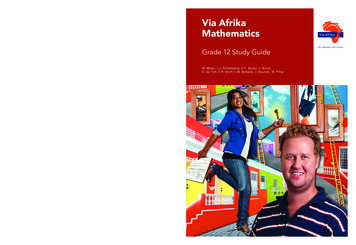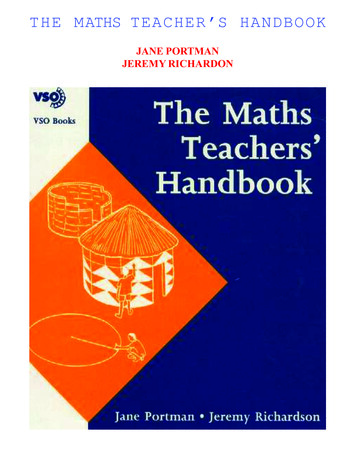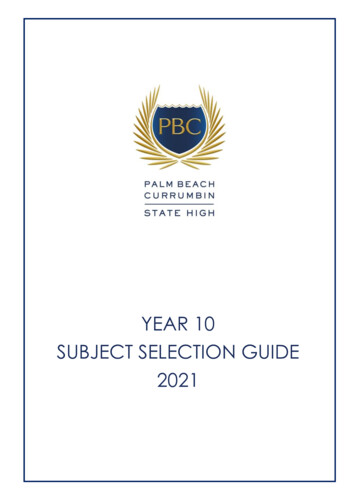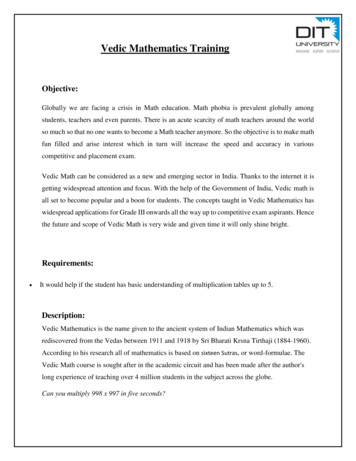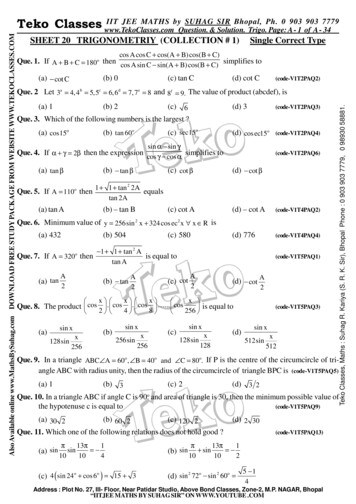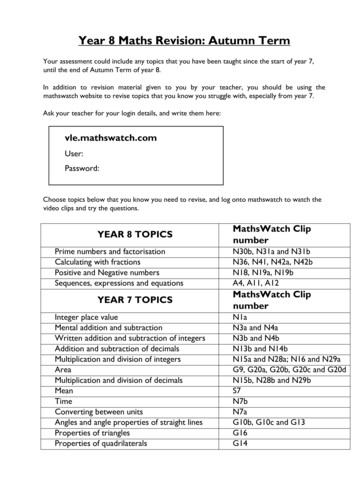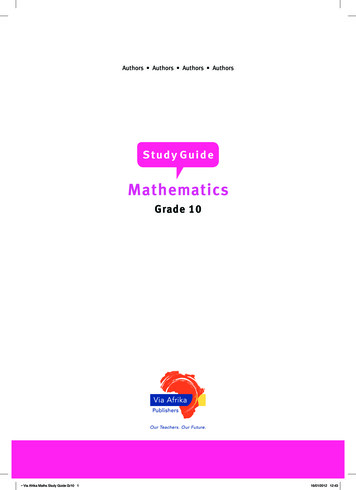
Transcription
Authors Authors Authors AuthorsS tu d y G u i d eMathematicsGrade 10 Via Afrika Maths Study Guide Gr10 116/01/2012 12:43
ContentsIntroduction to Mathematics.5Chapter 1 Algebraic expressions 6Overview 6Unit 1 The number system 7Unit 2 Multiplying algebraic expressions 8Unit 3 Factorisation 10Unit 4 Algebraic fractions 13Questions 15Chapter 2 Exponents 16Overview 16Unit 1 Laws of exponents 17Unit 2 Simplifying exponents 18Unit 3 Solving equations that contain exponents 20Questions 23Chapter 3 Number patterns 24Overview 24Unit 1 Linear number patterns 25Unit 2 More complicated linear number patterns 27Questions 29Chapter 4 Equations and inequalities 30Overview 30Unit 1 Linear equations 31Unit 2 Quadratic equations 34Unit 3 Literal equations 35Unit 4 Simultaneous equations 37Unit 5 Linear inequalities 38Questions 40Chapter 5 Trigonometry 41Overview 41Unit 1 Right-angled triangles 42Unit 2 Definitions of the trigonometric ratios 43 Via Afrika Maths Study Guide Gr10 216/01/2012 12:43
Unit 3 Special triangles 44Unit 4Using your calculator 45Unit 5 Solving trigonometric equations 46Unit 6Extending the ratios to 0 θ 360 48Unit 7Graphs of the trigonometric functions 53Questions 55Chapter 6 Functions 57Overview 57Unit 1 What is a function? 58Unit 2 Graphs of functions 60Unit 3 The graph of y ax2 q 63Unit 4 The graph of y ax q 64Unit 5 The graph of y abx q, b 0 and b 1 66Unit 6 Sketching graphs 68Unit 7Finding the equations of graphs 71Unit 8 The effect of a and q on trigonometric graphs 72Questions 74Chapter 7 Polygons 75Overview 75Unit 1 Similar triangles 76Unit 2 Congruent triangles 78Unit 3 Quadrilaterals 80Questions 83Chapter 8 Analytical geometry 84Overview 84Unit 1 The distance formula 85Unit 2 The gradient formula 86Unit 3 The midpoint formula 88Questions 89Chapter 9Finance, growth and decay 91Overview 91Unit 1 Simple interest 92Unit 2Compound growth 94Questions 97 Via Afrika Maths Study Guide Gr10 316/01/2012 12:43
Chapter 10 Statistics 98Overview 98Unit 1 Measures of central tendency: ungrouped data 99Unit 2 Measures of dispersion 101Unit 3 Box-and-whisker plot 103Unit 4 Grouped data 104Questions 107Chapter 11 Measurement 110Overview 110Units 1 and 2 Right prisms and cylinders 111Unit 3 The volume and surface area of complex-shaped solids 113Questions 116Chapter 12 Probability 117Overview 117Unit 1 Probability 118Unit 2 Combination of events 120Questions 122Exam Papers 123Answers to questions 133Answers to exam papers 152Glossary 162 Via Afrika Maths Study Guide Gr10 416/01/2012 12:43
Introduction to MathematicsThere once was a magnificent mathematical horse. You could teach it arithmetic, whichit learned with no difficulty, and algebra was a breeze. It could even prove theorems inEuclidean geometry. But when it tried to learn analytic geometry, it would rear back onits hind legs, and make violent head motions in resistance.The moral of this story is that you can’t put Descartes before the horse. If you havea study routine that you are happy with and you are getting the grade you want fromyour mathematics class you might benefit from comparing your study habits to the tipspresented here.Mathematics is Not a Spectator SportIn order to learn mathematics you must be actively involved in the doing and feelingof mathematics.Work to Understand the Principles LISTEN During Class. No the study guide is not enough. In order to get somethingout of the class you need to listen while in class. Sometimes important ideas will notbe written down, but instead be spoken by the teacher.Learn the (proper) Notation. Bad notation can jeopardise your results. Payattention to them in the worked examples in this study guide,Practise, Practise, Practise. Practise as much as possible. The only way to reallylearn how to do problems is work through lots of them. The more you work, thebetter prepared you will be come exam time. There are extra practise opportunitiesin this study guide.Persevere. You might not instantly understand every topic covered in amathematics class. There might be some topics that you will have to work at beforeyou completely understand them. Think about these topics and work throughproblems from this study guide. You will often find that, after a little work, a topicthat initially baffled you will suddenly make sense.Have the Proper Attitude. Always do the best that you can.The AMA of Mathematics ABILITY is what you’re capable of doing.MOTIVATION determines what you do.ATTITUDE determines how well you do it.It is not pure intellectual power that counts, it’s commitment. – Dana Scott Via Afrika – Mathematics Via Afrika Maths Study Guide Gr10 5516/01/2012 12:43
Chapter1Algebraic expressionsOverviewIn this unit, we discuss real numbers, which are divided into rational and irrationalnumbers. Here, you will also learn about surds, and how to round off real numbers. Youwill also learn how to multiply integers, monomials and binomials by a polynomial.Finally, we discuss factorisation and how to work with algebraic fractions.UNIT 1Page 7The number systemUNIT 2Page 8Multiplying algebraicexpressions Real numbers Surds Rounding off Multiply integers and monomials bypolynomials The product of two binomials Multiplying a binomial by a trinomial The sum and difference of two cubesCHAPTER 1 Page 6Algebraic expressionsUNIT 3Page 10FactorisationUNIT 4Page 13Algebraic fractions6 Via Afrika Maths Study Guide Gr10 6 Common factorsDifference between two squaresPerfect squaresTrinomials of the form x2 bx cTrinomials of the form ax2 bx cFactorising by groupingFactorising the sum and difference ofcubes Simplifying fractions Products of algebraic fractions Adding and subtracting algebraic fractions Via Afrika – Mathematics16/01/2012 12:43
Unit1The number system1.1 Real numbers Real numbers are divided into rational and irrational numbers.Naturalnumbers (N)Wholenumbers (N0)Integers (Z)Rationalnumbers (Q)Realnumbers (R)Zero NegativenumbersFractions of the form ba , a, b Z, b 0Irrationalnumbers (Qʹ)We can write a rational number as a fraction, ba , where a and b Z, and b 0.We cannot express an irrational number as a fraction.1.2 Surds A surd is a root of an integer that we cannot express as a fraction.Surds are irrational numbers.Examples of surds are 3 and 2 .1.3 Rounding off If the number after the cut-off point is 4 or less, then we leave the number beforeit as it is.If the number is equal to 5 or more, then increase the value of the number beforeit by 1. Via Afrika – Mathematics Via Afrika Maths Study Guide Gr10 7716/01/2012 12:43
Unit2Multiplying algebraic expressions2.1 Multiply integers and monomials by polynomials Each term inside the bracket is multiplied by the term in front of the bracket. (– 16 a2b ¿ 6abc) – (– 16 a2b ¿ 12ac) (– 61 a2b ¿ 18b)– 16 a2b(6abc – 12ac 18b) –a3b2c 2a3bc – 3a2b22.2 The product of two binomials Each term inside the first set of brackets is multiplied by each term inside the secondset of brackets.(a – 3b)(a 7b) (a a) (a 7b) – (3b a) – (3b 7b) a2 7ab – 3ab – 21b2 a2 4ab – 21b2 When squaring a binomial:(m n)2 (m n)(m n) (m m) (m n) (n m) (n n) m2 mn nm n2 m2 2mn n2A common error is to think that(m n)2 m2 n2The square of any binomial produces the following three terms:1 The square of the first term of the binomial: m22 Twice the product of the two terms: 2mn3 The square of the second term: n22.3 Multiplying a binomial by a trinomialMultiply each term in the first set of brackets by each term in the second set of brackets.Then we simplify by collecting the like terms. (8 – 3y)(12 – 2y 8y2 – 4y3) (8 12) (8 –2y) (8 8y2) (8 –4y3) (–3y 12) (–3y –2y) (–3y 8y2) (–3y –4y3) 96 – 16y 64y2 – 32y3 – 36y 6y2 – 24y3 12y4 96 – 52y 70y2 – 24y3 12y48 Via Afrika Maths Study Guide Gr10 8 Via Afrika – Mathematics16/01/2012 12:43
Unit22.4 The sum and difference of two cubes The expression in the following form gives the difference of two cubes:(a – b)(a2 ab b2) a3 a2b ab 2 – a2b – ab 2 – b3 a3 – b3 The expression in this form gives the sum of two cubes:(a b)(a2 – ab b2) a3 – a2b ab2 a2b –ab2 b3 a3 b3 Via Afrika – Mathematics Via Afrika Maths Study Guide Gr10 9916/01/2012 12:43
Unit3FactorisationFactorisation is the opposite process to the one you learnt in the previous unit whenmultiplying out algebraic expressions.expandy(x 5)xy 5yfactorise3.1 Common factorsWhen finding a common factor, we find and take out a factor that can divide into eachterm in the expression. For example, in the expression 6h3 18h2, 6h2 can divide intoeach term, so it becomes the common factor:6h3 6h2 h18h2 6h2 3Therefore:6h3 18h2 6h2(h 3)3.2 Difference between two squaresA difference of two squares occurs when we have two perfect squares separatedby a minus sign. An expression in the form a2 – b2 has two factors, (a – b)(a b).For example:24224a – 81b (2a 9b )(2a – 9b ) 4a2 2a 81b4 9b23.3 Perfect squaresIn Unit 2 you learnt that (x y)2 x2 2xy y2. Therefore, a trinomial will factorise intoa perfect square if: the first and last terms are perfect squares (e.g. x x x2) the middle term is equal to 2 first term last term.For example: x2 10x 25 (x 5)(x 5) (x 5)210 Via Afrika Maths Study Guide Gr10 10 Via Afrika – Mathematics16/01/2012 12:43
Unit33.4 Trinomials of the form x2 bx cWhen factorising a trinomial: If the third term of the trinomial is positive, we use the sum of the factors of the thirdterm to give us the middle term. If the third term of the trinomial is negative, we use the difference between thefactors of the third term to give us the middle term.Use the following rules to decide on the signs in the binomials: If the third term of the trinomial is positive, then the signs between the terms in thebinomials are the same (both positive or negative). If the third term of the trinomial is negative, then the signs between the terms of thebinomials are different.For example: x2 3x 2 (x 2)(x 1)3.5 Trinomials of the form ax2 bx cIn this case, the rules are the same as in the previous section, except that now we needto consider the factors of the coefficient of x2 and the last term.For example: 6x2 x – 15 Multiply the coefficient of the squared term (6) by the last term (–15) –90. Look for the factors of –90 that will give 1 (the coefficient of the middle term) whenadded:–9 10 –90 and –9 10 1Remember to changethe sign inside the Rewrite 6x2 x – 15 as 6x2 10x – 9x – 15.brackets when you2 Group the terms: (6x 10x) – (9x 15)divide by –1. Take out common factors from each set of brackets:2x(3x 5) – 3(3x 5) (3x 5)(2x – 3)Therefore:6x2 x – 15 6x2 10x – 9x – 15 2x(3x 5) – 3(3x 5) (3x 5)(2x – 3)3.6 Factorising by groupingIf an expression has four or more terms, but has no factor common to all of them, wecan often group the terms, factorise each group, and then remove a common factor. Via Afrika – Mathematics Via Afrika Maths Study Guide Gr10 111116/01/2012 12:43
Unit3x3 – 3x2 2x – 6 (x3 – 3x2) (2x – 6) (Group terms together using brackets) x2(x – 3) 2(x – 3) (Factor out the common factors from each group) (x – 3)(x2 2)3.7 Factorising the sum and difference of cubes The difference betweentwo cubes factorisesas: a3 – b3 (a – b)(a2 ab b2)33 The first factor is: ( first term ) – ( second term ) The second factor is: (Square of the first term) (Opposite sign) (Product of the twoterms) (Square of the last term)For example: y3 – 64 (y – 4)(y2 4y 16)The sum of two cubes factorises as: a3 b3 (a b)(a2 – ab b2)For example: y3 64 (y 4)(y2 – 4y 16)12 Via Afrika Maths Study Guide Gr10 12 Via Afrika – Mathematics16/01/2012 12:43
4UnitAlgebraic fractions4.1 Simplifying fractionsSpecial fractions:Negative fractions: 1a a 1a 1a aa 1 0a 0But: 0a is undefineda –a –b – ba b a –a –bb–a –b But: – ba To simplify a fraction:1 Factorise the expressions in the numerator and denominator2 Cancel the terms common to both.(x2 – 4) (x 2)(x – 2)For example: (x – 2) (x – 2) (x 2)4.2 Products of algebraic fractionsMultiplying and dividing algebraic fractions works in the same way as ordinary fractionsthat contain numbers: Factorise each expression. Cancel any like terms. Multiply what is left.22(4n – 9)(2n – n – 3)(2n 3)(2n – 3)(2n – 3)(n 1) (2n 3)(n 1)(2n 3)(2n – 3)(n 1)(2n – 3) 1 1 (2n – 3)2Multiply each term in the first set of brackets by each term in the second set of brackets.Then we simplify by collecting the like terms. Via Afrika – Mathematics Via Afrika Maths Study Guide Gr10 131316/01/2012 12:43
4Unit4.3 Adding and subtracting algebraic fractionsAs always, factorise and simplify where possible.Find a common denominator.Express each fraction in terms of that denominator.Add and subtract the like terms. 3p – q2p – 3q 2p 4q2q(3p – q) p(2p – 3q) 4pq2x 5 – x – 2 533(2x 5) – 5(x – 2) 156pq – 2q 2p – 3pq6x 15 – 5x 10 152p2 3pq – 2q2 15 22 4pq 4pqx 25(2p – q)(p 2q) 4pq14 Via Afrika Maths Study Guide Gr10 14 Via Afrika – Mathematics16/01/2012 12:43
Questions1 Multiplying expressions:a Square the binomial (3x 4).b Expand: (2x 5)(2x 1)c Expand: (2a b)(4a2 – 2ab b2)d Find the products and simplify: (2a – 5b)(4a – 3b) – (a 3b)(5a – 12b)e Find the product: (k2 34 )(k – 12 )2 Factorise the following expressions:a 25x2 30x 9b 5x2 7x – 6c x3 – 14 xd (2t – 5)3 – (2t – 5)2e 3x3 x2 3x – 1f m3 – m2 – mn2 n2g (y 3)(2y – 3) (y – 1)(3 – 2y)h x2(2x – 1) – 2x(2x – 1) – 3(2x – 1)3 Algebraic fractions:a2x –x–6 Simplify x2 – 4x 332– 9x b Simplify to the lowest terms: 4x4x3 6x2c2Simplify as far as possible: x –47x– x 12 a(a 1) (a 1)22 a a–2 1 aa2 – aa d Simplify as far as possible: a2 – 2a 1 ¿e1 –4 – x 1 2 Calculate and simplify: x – 2 (x 2)2f 2 – 8 –32p Calculate and simplify: p2 – p – 12 3 p Via Afrika – Mathematics Via Afrika Maths Study Guide Gr10 15p–31516/01/2012 12:43
Chapter2ExponentsOverviewAs you know, we can describe numbers in terms of their factors. For example,125 5 5 5. We can also write this another way, in exponential form: 125 53.Here, 5 is the base, and 3 is the exponent. An exponent is also sometimes called anindex or a power. In this chapter, you learn about the laws of exponents, how to simplifyexponents and how to solve equations that contain exponents.UNIT 1Page 17Laws of exponentsUNIT 2Page 18Simplifying exponentsCHAPTER 2Page 16ExponentsUNIT 3Page 20Solving equations thatcontain exponents16 Via Afrika Maths Study Guide Gr10 16 What is an exponent? The laws of exponentsThe product rule: bm ¿ bn b(m n)The quotient rule: bm bn b(m n)Rules for 0 and 1Power rule: (bm)n bmnAll inside brackets raised to a power:n ba )n ban (ab)n anbn and ( 1 , provided Negative power rule: a–n anthat a 0 Solving exponential equations usingfactorisation Exponents containing fractions Three common mistakes to avoid whenworking with exponents Via Afrika – Mathematics16/01/2012 12:43
Unit1Laws of exponents1.1 What is an exponent?In general, we define exponents as follows:xn x x x x x, n NThis definition states that x is multiplied by itself n times. Here, x is the base, and n isthe exponent.1.2 The laws of exponents bm bn b(m n)(The product rule)mn(m – n)b b bwhere m n and b 0 (The quotient rule)0a 1, when a 0(bm)n bmn(The power rule)nn n(ab) a ba–1 1a , when a 0 Via Afrika – Mathematics Via Afrika Maths Study Guide Gr10 17Note that, for theserules, the base staysthe same.1716/01/2012 12:43
Unit2Simplifying exponentsIn this unit, we revise how to use the laws of exponents to simplify expressions.2.1 The product rule: bm bn b(m n)The product rule tells you that, when multiplying powers that have the same base, youcan add the exponents.Example123x5 x3 x5 3 x823 2–2 23 (–2) 21 22 23x 22 21 3x 2 23x 32.2 The quotient rule: bm bn b(m – n)The quotient rule tells you that you can divide powers with the same base bysubtracting the exponents.Example5x5–11 x4x xAn exponentis also called apower.322 23 – 5 2–2256 612a b –3a6 – (–2)b6 – 3 –3a8b33 –4a –2b32.3 Rules for 0 and 1Rulesx1 x121 121n 114 1 1 1 1 110 1x0 1, x 0Anything tothe power zerois equal to 1,except 00, whichis undefined.Example1 16a0, a 02 16 1 163 (2 x)0 14 (–3)0 – 30 1 – 1 03a0b 05 ( 3a ) 32 1 52 218 Via Afrika Maths Study Guide Gr10 18[(–3)0 1 and 30 1]Everythinginside a bracketto the power ofzero is alwaysone. Via Afrika – Mathematics16/01/2012 12:43
Unit22.4 Power rule: (bm)n bmnThe power rule tells us that to raise a power to a power, just multiply the exponents.Example1 5(a2)3 52 3 56222 (27 ) 3 (33 ) 3 32 93113 (a–3. b 3 .c)3 a–3 3. b 3 3.c1 3 a–9.b.c3 bc a9Always expressanswerswith positiveexponents.2.5 A ll inside brackets raised to a power:aan(ab)n anbn and ( b )n bn Example1 (5a2)3 53a2 3 125a62 (2x2y)5 25x5 2y1 5 32x10y5x3xax3 3a2 2x bb4 2x.3x (2.3)x 6x5 (2a6b)3(3a2b3)2 (23a6(3)b3)(32a2(2)b3(2)) (8a18b3)(9a4b6) 72a18 4b3 6 72a22b9( )Switch thedenominatorand numeratorand multiply.12.6 Negative power rule: a–n a –n , provided that a 0Any non-zero number raised to a negative power equals its reciprocal raised to theopposite positive power.Example2211 22 1– 3 12 35b b1 b a1 a5b2 a53 a5 2 a12 x2 ax2 x22 23ax x x a3x1 3 1 3 a x a a2 a3 a5x3x3 3 1 4 (3x)29x2.x33x52 34 4a b 4b 3ab1 Via Afrika – Mathematics Via Afrika Maths Study Guide Gr10 193a31916/01/2012 12:43
Unit3Solving equations that contain exponentsThe key to solving equations that contain exponents is to ensure that the bases on bothsides of the equation are the same. This enables us to compare the exponents, and sosolve for the variable. The rule is:If ax an, then x nExample13x 81 34[Rewrite 81 in exponential form: 81 34]Therefore, x 42 7x – 3 49[Rewrite 49 in exponential form: 49 72]7x – 3 72x – 3 2[Exponents are equal if bases are equal]x 53 3.9x – 1 27–x [Make the bases the same by applying the laws of exponents]3.32(x – 1) 33(–x)31 2x – 2 3–3x32x – 1 3–3x2x – 1 –3x2x 3x 15x 1x 15 4 2x 1 9[Move terms without x to the right side of the equation]x2 9 – 1 8x2 23[8 23]Therefore, x 3 according to the principle of same bases.3.1 Solving exponential equations using factorisationBefore we remove a common factor from an expression, we sometimes need to apply thelaws of exponents in reverse.Example1 2x 1 2x 242x.2 2x 242x(2 1) 243.2x 242x 24 320 Via Afrika Maths Study Guide Gr10 20[Use the reverse of the product rule: 2x 1 2x 21][Take out a common factor of 2x] Via Afrika – Mathematics16/01/2012 12:43
Unit2x 82x 23x 32 3x 1 3x – 1 903x(31 3–1) 903x(3 31 ) 903[Take out a common factor of 3x] 10 903x (3 )3 3x 90 103x 273x 33x 3x 13 2 2x 42x 1 – 2x 42x(2 – 1) 42x 4(4 1 4)2x 22Therefore, x 2[The bases are the same, so exponents are equal][Move terms containing x to the left side of the equation][Take out a common factor of 2x]3.2 Exponents containing fractionsFractions often make expressions look more complicated, but we use all the same rulesand laws of exponents.Example551 4 2 (22 ) 2 25 322 x98 (33x–12) 32x–8 1 [Remember to express exponents as positive numbers]13 (33 ) 3 31 33 27 1 x98 4 (27x12 ) 3 (33)2.(x12)2 32x8 2y 2y2 y y2 2y y b 2 b 2y 44a 2 . a 2a2a 5 y y 2 1 b – b2 43.3 T hree common mistakes to avoid when working withexponents3.3.1 BracketsThe exponent next to a number only applies to that number. However, if the numbersare inside brackets, and the exponent lies outside the brackets, then the exponentapplies to everything inside the brackets. For example:–32 (–3)2 –3 ¿ 3 (–3)(–3) Via Afrika – Mathematics Via Afrika Maths Study Guide Gr10 212116/01/2012 12:43
Unit33.3.2 The product rule1 The product rule only applies when the bases are the same. For example:23 ¿ 32 652 The product rule only applies when multiplying, not when adding. For example:23 25 283.3Working backwards to go forwardsRemember, we need the bases to be the same before we can apply the laws of exponents.Therefore, first write all bases as a product of their prime factors, and then apply thelaws of the exponents to those bases that are the same.27 33 81 34 32 25 36 22 33 40 23 51Example9 3212 3 4 3.226 2 34 22Therefore:nn 1(32)n ¿ (3.22)n 19 ¿ 12 4 ¿ 6n22 ¿ (2.3)n2nn 12n 23 ¿3¿2 22 ¿ 2n ¿ 3n 32n n 1 – n ¿ 22n 2 – 2 – n 32n 1 ¿ 2n22 Via Afrika Maths Study Guide Gr10 22 Via Afrika – Mathematics16/01/2012 12:43
Questions1 Simplify the following expressions by applying the laws of exponents. All indicesmust be positive, and all variables represent positive rational numbers.a(2an – 2)2–2 a2a 3 c 6ax 1x–1a–1a 127 .9 e 3x – 1.81x 1b5x0 8 3 – ( 21 ) .1x–2–212x2.x4 – (–3x3)2d 3x3–32 xf 3–1x–24 .81 h – 3a0 2 7 3 – 1 3 g –2 2a – 2.6a 112 8 3 4ax2a – b x i xb – 2ax2bn–35Calculate b if b 5n 1If 5x f, express 2.25x 1 in terms of f.If 3m 5, find the value ofi 3m 2 ii 9–2md Remove the brackets and simplify: (32x – 3)(32x 3)3 Solve the following equations:a 2x 1 2 b 9x – 2 271 – 2xc 52x 1 0,04 d 5x 1 5x – 150 04 An astronomer studying a region of space needs to determine the volume of a cubicregion. The edges of the region measure 3 108 miles long. Find the volume.2 abc Via Afrika – Mathemati
Grade 10 Via Afrika Maths Study Guide Gr10 1 16/01/2012 12:43. Contents Introduction to Mathematics . 5 Chapter 1 Algebraic expressions 6 .

